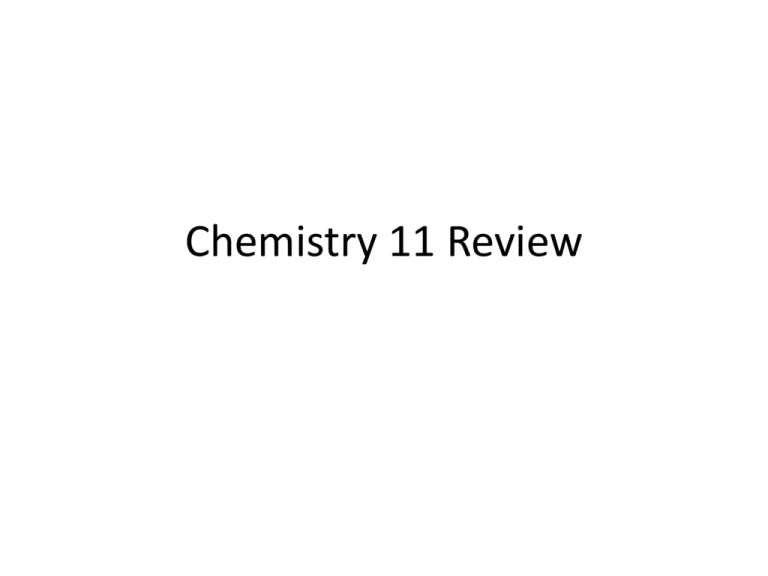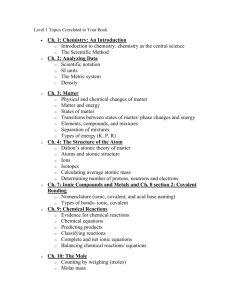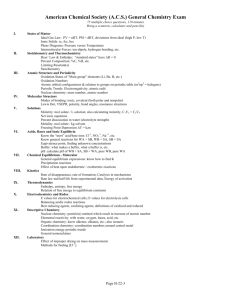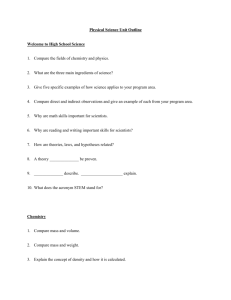File - Mr. Chio's Chemistry 11
advertisement

Chemistry 11 Review Unit 1: Safety • Safety Equipment in the classroom – Fume Hood – Broken Glass Container – Fire Blanket – Emergency Shower – Eye Wash Station – ETC ETC Unit 1: Safety • First Aid Personnel – Mr. Chio – Mr. Ngo (next door teacher) – Office – Safe School Liason Unit 1: Safety • Common Hazards – Broken Glass – Fire – Chemical Spill – Fumes in the air – Chemical in eye – ETC ETC Unit 1: Measurement • SI Units (g, L, m) • SI Unit conversion between base unit and prefixes (mg, g, kg, mL, L, kL, mm, m, km) • Precision vs Accuracy • Sig Figs • Calculations involving sig figs • Scientific Notation Unit 1: Unit Conversion • What you want is always on the “top” or “bottom” • Always remember your conversions for SI units – 1kg = 1000g – 1mg = 0.001g • Calculate at the very end! Unit 2: Matter • What is matter? – Anything that has mass and takes up volume • Hypothesis vs Theory vs Law • Physical vs Chemical properties – Physical = any property that uses 5 senses – Chemical = reactivity properties • Matter – Solid, Liquid, Gas Unit 2: Matter • • • • • Classification of Matter Homogeneous vs Heterogeneous Pure Substance vs Solution Mixtures Mechanical Mixtures vs Homogeneous Mixtures Unit 2: Matter • Intensive Properties – Doesn’t matter about how much • Extensive Properties – Matters about how much you have • Quantitative vs Qualitative • Kinetic Molecular Theory – Bouncey Balls that do not lose energy Unit 2: Matter • Physical vs Chemical change – Physical Change = no new substance is formed – Chemical Change = new substance is formed Unit 2: Matter • Types of Separations – Hand Separation – Filtration – Evaporation – Distillation – Solvent Extraction – Recrystallization – Gravity Separation – Chromatography Unit 2: Nomenclature • Second element ends in IDE! • Ionic Compounds – – – – Criss Cross method Reduce Never write 1 Multi-valents use roman numerals • Use the non-metals charge that never changes to find its charge – Polyatomics are grouped together and carry a charge • Covalent follows the same rule, except no charge – Their names have pre-fixes • Hydrates are water molecules at the end, use prefixes to say how many Unit 2: Nomenclature • Acids start with H • Ionic acids that end in – IDE turns into IC – ATE turns into IC and drops the hydro – ITE turns into OUS Unit 3: Mole Concept • • • • • Everything combines in whole ratios Avogadro's number Molecules vs Atom # How to find atomic mass STP! – Only for gases at STP – 22.4L/mol Unit 3: Mole Concept • Molecular vs Empirical Formula – Percent composition • How to find • Make percent = g – – – – Percent to mass Mass to moles Divide by smallest Multiply til whole! – Molecular formula needs molar mass Unit 3: Mole Concept • Mol/L • Can use density and molar mass to find concentration • Dilution – C1V1 = C2V2 – If mixing two of the same solution. You add the concentration at the end! Unit 4: Chemical Reaction • • • • • Reactants to Products Coefficient = # of moles Conservation Laws Closed vs Open Systems Balancing chemicals – – – – – – Solve metals first Balance all elements that are with the metals Balance O and H last Balance polyatomics as 1 unit Use fractions Multiply til whole • States of matter! Unit 4: Chemical Reactions • • • • • • Synthesis Decomposition Single Replacement Double Replacement Combustion Acid/Base Neutralization Unit 4: Chemical Reactions • • • • • Synthesis = exothermic Decomposition = endothermic Exothermic vs endothermic Enthalpy is the heat of a reaction Page 122 has a summary aid for energy Unit 4: Stoichiometry • Cross the mole bridge! • Convert to moles first • Molar concentration – Convert to moles first! • Titration – Balance and know that the moles of acid = moles of base at equivalence point Unit 4: Stoichiometry • Limiting Reagent – Determines how much product you will form • Percent Yield – Determines how much yield you will get – Actual/theoretical • Percent Purity – Determines how much yield you will get based on how pure your substance is Unit 5: Atomic Theory • • • • • • Democritus (matter/atoms) Aristotle (ancient elements) Dalton (atoms) Thomson (electrons) Rutherford (protons and nucleus) Bohr (orbitals) Unit 5: Atomic Theory • Subatomic Particles – Electrons – Protons – Neutrons • Atomic number vs Atomic Mass • Isotopes – Different neutrons so different mass • Average atomic mass – Multiply percentage by mass and add Unit 5: Atomic Theory • Mendeleev developed the periodic table from the reaction with oxygen • Arranged them by mass • Periodic Trends – – – – – – Your periodic table EN IE Radii Reactivity Metallic properties Unit 5: Atomic Theory • Electron Configuration – Orbitals • Core Notation – Noble gases need to be written by previous rows noble gases • Half and Full filled d-orbitals • Predicting Valence Electrons – Only s and p orbitals Unit 5: Atomic Theory • Ionization Energy and Electronegativity • Ionic Bonds • Covalent Bonds – Polar vs Non-polar • Metallic Bonds • London Forces vs Dipole-Dipole forces Unit 5: Atomic Theory • • • • Lewis Structures 8 x #atoms (except hydrogen = 2) Valence electrons Substance the two to find bonds – Exceptions are B, Be, and Al • Octet rules still apply! • PCl5 can have more than 4 bonds Unit 6: Solution Chemistry • Solutions are homogeneous mixtures – Solvents – Solutes • Solubility – The amount of substance in mass dissolved in 100mL of water • Saturated vs Unsaturated • Like dissolves like Unit 6: Solution Chemistry • Polar and Non-polar solvents • Dissolving which one? – Polar dissolves ionic – Non-polar cannot dissolve ionic • Solvation = hydrating an ionic solid Unit 6: Solution Chemistry • Conductivity – Metals – Ionic solutions – Acids or bases • Covalent and organic compounds do not conduct • Solids do not conduct unless they are metal Unit 6: Solution Chemistry • • • • Ions have concentration too Must balance the dissociation equation Follow the mole conversion If mixtures, dilute first and add common ions Good Luck!





